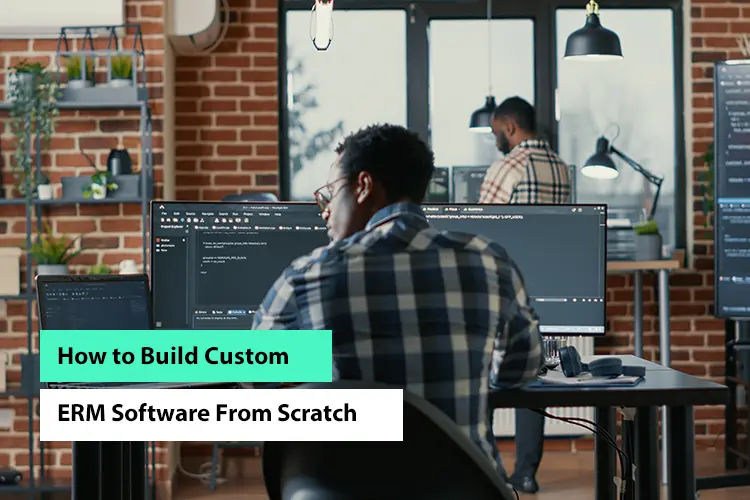How to Build Custom ERM Software From Scratch

Have you ever felt like your business is juggling too many balls at once, struggling to keep up with the ever-increasing demands of the modern marketplace? In a world where data is the currency of success, how can you ensure your organization not only survives but thrives amidst the chaos?
Imagine having a tool that’s not just a lifeline but a catalyst for your business growth, a software solution so precise and tailored that it seamlessly adapts to your unique needs, allowing you to master the art of resource management effortlessly. This is where the world of Custom Enterprise Resource Management software steps in – a game-changing answer to the relentless challenges businesses face today.
In this blog, we’re about to unlock the doors to a new era of efficiency, adaptability, and resource management excellence. We’ll dive deep into the world of custom ERM software, exploring the problems it solves, the reasons why it’s an investment worth making, and the best practices to embark on a transformational journey. So, are you ready to take your business from surviving to thriving? Let’s get started!
What is Custom ERM Software?
Custom ERM software, or Custom Enterprise Resource Management software, represents a highly specialized and personalized approach to managing the vast array of resources and data within an organization. ERM is a comprehensive system that encompasses various business processes, including finance, human resources, inventory, procurement, project management, and more. While traditional ERM software solutions offer a standardized approach to these functions, ERM software is uniquely designed and developed to cater specifically to the needs, intricacies, and workflows of a particular organization.
Why Invest in Custom ERM Software?

Investing in custom Enterprise Resource Management (ERM) software is a strategic move that can offer numerous benefits to organizations. While off-the-shelf ERM solutions can provide a general framework for managing resources and data, custom ERM software consultants takes this to the next level by tailoring the system to meet your organization’s specific needs and objectives. Here’s an expanded look at why investing in ERM software is a wise decision:
Tailored to Your Unique Needs
Custom ERM software is designed from the ground up to align with your organization’s specific processes, workflows, and industry requirements. It considers the way you operate, making it a perfect fit for your unique needs. This tailored approach ensures that the software adapts to your business rather than the other way around.
Competitive Advantage
In today’s dynamic business landscape, staying ahead of the competition is crucial. Custom software allows you to build features and functionalities that set you apart. You can create proprietary processes, innovative tools, and unique capabilities that give you a competitive edge in your industry.
Scalability
As your organization grows, your software needs to grow with it. Custom ERM software is highly scalable and can be expanded to accommodate increased data, users, and complexity. This scalability ensures that your software can support your business as it evolves and expands.
Efficiency and Automation
Custom Enterprise Resource Management software can automate and optimize critical business processes, reducing manual labor, errors, and delays. This leads to improved efficiency, cost savings, and faster decision-making. You can streamline everything from order processing to financial management.
Data Security and Compliance
Many industries have specific security and compliance requirements that off-the-shelf software may not fully address. With custom ERM software, you have the flexibility to build robust security measures and ensure compliance with regulations like GDPR, HIPAA, or industry-specific standards.
Long-Term Cost Efficiency
While the initial investment in custom Enterprise Resource Management software development may be higher, it often proves to be cost-effective over time. You eliminate ongoing licensing fees associated with off-the-shelf solutions, avoid costly third-party integrations, and reduce the risk of operational disruptions that can come with adapting generic software to your organization.
Also Read Our Blog: How To Choose The Best Offshore Software Development Services
Increased ROI
Custom ERM software can yield a higher return on investment (ROI) than generic solutions. The efficiency gains, improved decision-making, and competitive advantages can have a direct impact on your bottom line. It can lead to increased revenue, cost savings, and a more profitable business.
Innovation and Adaptability
In rapidly changing markets, the ability to innovate and adapt quickly is critical. Custom ERM software allows you to respond to market shifts and changing business conditions with agility. You can add or modify features, integrate new technologies, and stay ahead of industry trends.
User-Friendly Design
With custom ERM software, the user interface (UI) and user experience (UX) can be designed to be intuitive and user-friendly, taking into consideration the specific needs and preferences of your employees. This leads to faster user adoption, increased productivity, and reduced training costs.
Support and Maintenance
You have control over support and maintenance. You can establish a dedicated in-house team or outsource it to ensure that your software remains up to date and performs at its best.
Investing in custom Enterprise Resource Management software is a strategic choice for organizations that seek to optimize their operations, gain a competitive edge, and adapt to changing business environments. It provides a highly tailored, scalable, and efficient solution that can lead to long-term cost savings and, most importantly, help you achieve your business goals and objectives more effectively.
How to Build Custom ERM Software: Best Practices

Building custom Enterprise Resource Management (ERM) software is a complex and critical undertaking that requires careful planning, technical expertise, and a deep understanding of your organization’s needs and processes. Here, we expand on the best practices for developing custom ERM software to ensure its successful implementation:
Clear Objectives and Requirements: Begin by defining clear objectives for your custom ERM software. What specific problems or inefficiencies do you aim to solve? These objectives should align with your organization’s strategic goals.
Engage Key Stakeholders: Involve key stakeholders in the planning and development process. This includes department heads, employees who will be using the software, and other decision-makers. Their input is invaluable for identifying and prioritizing features and functionalities.
Select the Right Development Team: Choosing the right development team is crucial. You need to hire dedicated mern stack developers or other skilled developers and project managers who understand your industry, and your organization’s unique needs, and have experience building ERM systems. Consider in-house development or outsourcing to experts, depending on your resources and expertise.
User-Centric Design: The user interface (UI) should be user-friendly and intuitive. Consider the needs of both technical and non-technical users. Conduct user testing and gather feedback to refine the design for maximum usability.
Data Integration and Migration: Plan how existing data will be migrated to the new ERM system. A successful migration strategy is essential to ensure a smooth transition and to avoid data loss and operational disruptions.
Security and Compliance: Implement robust security measures to protect sensitive data. Depending on your industry, you may need to comply with specific regulations (e.g., GDPR, HIPAA). Ensure that your custom ERM software meets these requirements.
Testing and Quality Assurance: Thoroughly test the software to identify and address bugs, errors, and issues. Quality assurance processes are vital to ensure that the system works as intended and is free from vulnerabilities.
Training and User Adoption: Provide comprehensive training to your employees to ensure they can effectively use the new ERM software. User adoption is essential for the success of your custom solution. Offering ongoing support and training materials is beneficial.
Documentation and Knowledge Transfer: Maintain detailed documentation about the software’s architecture, features, and functions. This documentation is invaluable for future enhancements, updates, and for training new team members.
Continuous Maintenance and Updates: Custom ERM software requires ongoing maintenance to keep it up-to-date and functioning optimally. This includes bug fixes, security updates, and feature enhancements based on evolving needs.
Feedback and Improvement: Continuously gather feedback from users and stakeholders. This feedback loop allows you to make improvements and enhancements to your custom ERM software based on real-world usage and evolving business requirements.
Scalability and Future-Proofing: When developing your custom ERM software, consider scalability. Ensure that the system can grow and adapt to your organization over time. This future-proofing aspect is essential for long-term success.
Project Management: Effective project management is key to keeping the software development solutions process on track. Implement methodologies such as Agile or Scrum to allow for flexibility and adaptability as requirements change.
Budget and Timeline Management: Clearly define your budget and project timeline. Be prepared for potential delays and cost overruns, and ensure that you have a contingency plan in place.
Regular Evaluation and Optimization: After implementation, periodically assess the effectiveness of your custom ERM software. Identify areas for improvement and optimization, and be prepared to invest in enhancements as necessary.
Building custom ERM software involves a strategic and comprehensive approach. By following these best practices, you can create a system that aligns perfectly with your organization’s needs, streamlines operations, enhances efficiency and provides the flexibility to adapt to changing circumstances. Custom ERM software can be a powerful tool for achieving your business objectives and maintaining a competitive advantage in your industry.
Conclusion
Custom ERM software is a valuable investment for businesses seeking a competitive edge and a more efficient way to manage their resources. By building a solution from scratch, tailored to your unique needs, you can optimize your operations and adapt to changes in your industry. However, the process of developing custom ERM software requires careful planning, a skilled development team, and ongoing maintenance and improvements to ensure its success. When done right, custom ERM software can be a powerful tool for achieving your organization’s objectives and maintaining a sustainable competitive advantage.
Ready to embark on the journey of creating a custom ERM solution that perfectly fits your organization? Contact Imenso Software, our expert development team, to get started today! Your path to enhanced efficiency, competitive advantage, and resource management excellence begins with us.
We’re honored to mention that our efforts have been recognized by renowned B2B review and research platforms such as GoodFirms, Clutch, MirrorView, and many more.
Want more information about our services?
Similar Posts
How To Find The Most Reliable Remote Microsoft Power BI Consultants and Companies for Hiring?
Let’s rewind the event of March 2020, worldwide outbreak of Covid-19 left everyone in shock and life seemed to be at halt for quite sometime. Plenty of cases everyday and the count is still going on. However with new data being added we have moved a step closer each time to the vaccine development program....

Top Healthcare Software Trends to Watch Out for in 2023
Who would have imagined that telemedicine, formerly regarded to be nearly unachievable, might finally become a reality? Yet it has! To stay up with the most recent trends and advancements, the healthcare sector is quickly adapting as technology advances. While many new technologies and solutions powered by Artificial Intelligence (AI) and biomedical engineering will be […]...

AngularJS vs ReactJS vs VueJS: Which is Best for Your Business?
Are you facing the daunting task of choosing the perfect front-end technology for your business? Wondering which framework will best suit your needs and propel your projects toward success? Look no further! In this comprehensive blog, we aim to answer the burning question on every developer’s mind: AngularJS vs Top 3 Frontend Technologies: Which is […]...






